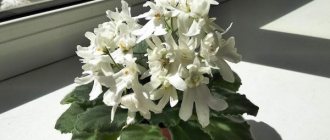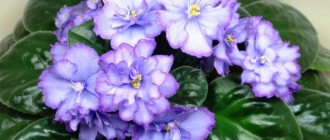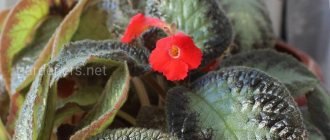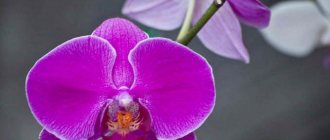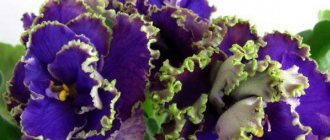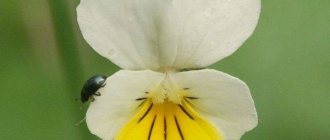Description
The shrub of this indoor violet is decorated with large buds. The center of the flower is painted white. Most of each petal is covered with bright colors: blue, pink, purple. When combined, several shades create an expressive pattern. The texture is semi-double. Experts note that the saturation of shades depends on the temperature conditions in which the violet grows.
The leaf color is standard green. With proper development, a uniform and small rosette is formed. The foliage shape is oblong and rounded. The first flowers appear after 9 months. With proper care, lush flowering is observed. Due to the original color, this variety stands out noticeably from others.
Officially, this variety and other indoor violets belong to the genus of herbaceous plants called Saintpaulia. All its representatives have a beautiful and expressive color.
Also, plants of this type combine growing and care conditions.
Wild rock violet
Synonyms. Sand violet (V. arenaria).
The leaves are small, round, heart-shaped at the base and obtuse-angled at the top, hard, with long petioles, arranged alternately on the shoots. Long peduncles with medium-sized (12-17 mm long) flowers with a small spur emerge from the leaf axils.
Growing conditions. Under natural conditions it grows on dry slopes, fields, wastelands and light pine forests. Prefers sandy, rocky or calcareous soil.
Use: Rarely used in culture. Can be cultivated in natural style gardens, planted in clumps under a sparse canopy of trees, on dry edges, lawns and rock gardens.
General rules of care
Plants belonging to the above genus need a sufficient amount of sunny color. A full day of light should be approximately 12-13 hours, but the plant must be protected from direct rays. Evening and morning light can touch the plant, it will not cause any harm.
Compliance with this condition is very important for a beautiful and expressive color.
When the indicator drops to below 15 degrees Celsius, the plant stops growing. In the hot season, the flower feels great in conditions of 24 degrees Celsius above zero. With the onset of cold weather, this indicator can be lowered. Experts strongly recommend not taking the shrub outside when it gets hot.
Indoor violets, like other houseplants, do not tolerate drafts. Also, their condition is significantly affected by sudden changes in temperature. The flower will feel great in a compact pot. These conditions are necessary for the formation of a large number of buds. Small plastic containers are ideal. The size of the container should be 3 times smaller than the plant's rosette.
Caring for a plant at home
Violets, flowers :
- Not capricious;
- And they are ready to grow in almost any soil.
But in order for the variety to fully reveal all its qualities and get a beautiful rosette with lush and symmetrical greenery, it is necessary to create suitable conditions for Saintpaulia .
Conditions of detention
needs additional lighting in winter
Otherwise, due to the short daylight hours:
- New buds will not be formed;
- And the flowering process will stop until the day length increases.
Proper watering and fertilizing
Water the violet in a tray or on top of the soil, avoiding water getting on the leaves and stem of the rosette. For irrigation, use settled water at room temperature.
For good growth and lush flowering, additional nutrients are added . To do this, use liquid fertilizers twice a month and apply them during watering.
Advice! If fertilizers are applied regularly with each watering, then the dose should be reduced by three times.
It is necessary to water violets as the soil dries.
Lighting and temperature
At low temperatures reaching 15 degrees Celsius, the plant :
- Slows growth;
- Or stops it altogether.
The flower also does not tolerate heat well; the optimal temperature for its growth and flowering is considered to be 22-24 degrees .
Daylight hours should be at least 10 hours; in winter, it is necessary to use additional lighting , since daylight hours are very short.
Air humidity
Air humidity should be between 50-70% . When the air is too dry, the plant begins to:
- Waste away;
- Dries the buds;
- And he might even die.
It especially suffers from dry air in winter, when batteries are actively working. To increase humidity in the room, place containers with :
- Water;
- Or wet expanded clay.
Attention! Use automatic humidifiers.
What kind of soil does he prefer?
The soil for Saintpaulia should be :
- Light;
- Breathable.
The following components are used to prepare the substrate :
You can collect soil for Saintpaulias with your own hands.
- High peat;
- Perlite;
- Vermiculite;
- Sphagnum moss.
Advice! When transplanting violets, it is important not to damage the root system of the plant. To do this, you need to pour soil into the bottom of the pot, place the plant and carefully cover it with soil, and do not compact it, but lightly tap on the walls of the container. If the soil has subsided a little, add more. Lightly moisten.
Pruning and hygiene
The florist must promptly remove:
- Faded buds;
- Yellowed and old leaves.
Grown unnecessary stepchildren are also removed . They take away nutrients from the plant.
Reproduction methods
The variety reproduces:
- Cuttings;
- Stepchildren;
- And planting flower stalks.
The variety is fertile for stepchildren; there can be up to 10 of them per year. The most convenient method to use is propagation by leaf cuttings .
Transplant rules, rejuvenation
The variety is transplanted as the children grow up , from smaller containers to larger ones, using the transshipment method.
Saintpaulias need to be replanted once a year.
An adult plant is replanted after every second flowering, at least once a year . But you shouldn’t overdo it either. Every transplant is stressful for the plant.
Composition of the earth
The correct substrate, which is sold in the store, is perfect for plants of the Saintpaulia genus. It contains all the necessary elements for the nutrition and development of the bush. In addition, the finished product does not need to be hardened or processed additionally. You can also prepare the mixture yourself, adhering to the following proportions: 0.5 parts turf soil, 2 parts leaf soil, 1 part humus and 1 part sand.
To the above components add a few pinches of bone meal and a spoonful of superphosphate. All elements are thoroughly mixed. The ideal soil for violets should be airy and low in acidity.
When replanting, be sure to line the bottom of the pot with drainage and make several holes.
Natural enemies of peacock butterflies
Photo: Peacock butterfly
Butterflies have many enemies in all forms - they are in danger at any stage of life. Adult butterflies suffer less than others, but even they often die in the claws or beaks of predators.
They are hunted by:
- rodents;
- birds;
- large insects;
- reptiles.
It was to protect against these enemies that the peacock’s eye acquired such a bright color. It would seem that she does not help with this at all, on the contrary, she gives out a butterfly! In fact, when her wings are open, she is always alert and ready to fly away from a predator, but when she is resting, she closes them and merges with the bark of the trees.
If the predator nevertheless noticed her and attacked, she sharply opens her wings, and for a moment disorients him due to the sharp change in color - this brief moment is sometimes enough for salvation. Most often, butterflies die because of birds, which are much faster and capable of grabbing them even in flight. It is more difficult for other predators to do this, so all that remains is to lie in wait for them.
Caterpillars are hunted by the same predators as adults, and even more actively - caterpillars are more nutritious, and are also much less mobile, and certainly cannot fly away. Therefore, a significant number of them are exterminated - it is already a great success to survive to the cocoon, and even more so to the imago, since the pupa is even more defenseless.
As in the case of adults, caterpillars suffer most from birds, which love to fly into their clusters and eat dozens of them at once. But reptiles and rodents are not far behind: it is difficult for them to catch an adult butterfly, but a larva is a completely different matter. They are even threatened by ants, who, through coordinated actions, can kill a caterpillar that is much larger than them.
They still have ways to protect themselves from enemies: they can take a threatening pose, as if they are going to attack themselves, they begin to crawl in all directions, if they still live together - so at least part of them will survive, curl up into a ball and fall to the ground. They may also secrete a green liquid, designed to scare away predators.
Watering
The first watering is carried out after transplanting the plant (if you purchased a rooted leaf or baby). Violet does not need constant moisture. It is enough to water the plant from time to time when the top layer of soil dries out. As a rule, the soil is moistened approximately once every 10 days. Warm water is used, which has been pre-settled for several days.
History of appearance
This type of violet was grown in the city of Vinnitsa; it was bred by Elena Lebedeva, a well-known specialist and breeder in her city.
The variety appeared recently, in 2012, and quickly gained popularity. The plant was named after Pauline Viardot, the famous Spanish-French singer, who is also known for her romantic relationship with Turgenev.
Top dressing
Every plant needs extra nutrients, especially flowering shrubs. For indoor violets, ready-made complex compositions are used. They are applied during foliage growth, once every 10 days (along with watering). During the flowering period, shrubs are not fertilized.
Diseases
Flower growers growing Saintpaulias encounter powdery mildew most often. Symptoms are a white coating on the green mass of the plant. If you notice brown marks on the leaves, this may indicate late blight. Because of this disease, the root system of the plant also begins to rot.
When a pale coating appears, know that you are dealing with gray mold. In this case, the affected areas are removed and the soil is changed. The sections are treated with a fungicide. Stagnation of water leads to fusarium, as a result of which the leaves and stems of the bush begin to rot.
Plant rust appears as small brown spots. Many diseases are treated by treating the flower plant with special preparations, according to the instructions.
It is also advisable to update the earthen mixture and disinfect the container.
Possible difficulties during cultivation
When growing, the grower may encounter fungal diseases.
The most common among them are:
- brown rot;
- gray rot;
- powdery mildew;
- late blight
Fungi are indicated by rot and plaque on different parts of the plant. To cure a violet, first transplant it into a new pot. When replanting, completely replace the soil. Affected parts of the plant should be removed. After replanting, treat the flower with a fungicide. A good option is Fundazol. Pests are also dangerous to the plant. These include insects, mites and worms.
Violets often grow on:
- nematodes;
- scale insects;
- false scale insects;
- whiteflies;
- spider mites;
- aphid;
- thrips.
Remove the parasites manually, then treat the flower with an insecticide. The preparations “Aktara”, “Agravertin” and others on the market are suitable for violets. Magic Tulip violets have a unique flower shape. However, in order to see flowering, it is necessary to fulfill all the whims of the plant, responsibly monitoring the microclimate in the room.
Pests
Mites are considered the most dangerous and common pests that attack house plants. Their presence is indicated by cobwebs on the leaves. Scale insects can also be a problem. They leave a sticky and viscous substance on the plant body.
Thrips harm both the green mass and the flowers of the bush. In this case, the plant is pruned and treated with a special preparation. The plant begins to rot from nematodes. Experts compare this pest to gray rot, but in this case there will be no plaque on the plant . The bush begins to quickly rot and wither when attacked by nematodes.
As a rule, the bush is destroyed and the earthen substrate is no longer used.
Inspect your violet regularly for symptoms of disease or pest attacks. If an illness is detected, use medicinal formulations. Regular inspection increases the chances of saving the plant. Before using medications, be sure to read the instructions for use.
For information on how to treat violets against ticks, see the video below.
What does the peacock butterfly eat?
Photo: Peacock butterfly
Nectar from numerous plants.
Among them:
- sivets;
- elder;
- dandelion;
- thyme;
- thistle;
- marigold;
- felt burdock;
- clover;
- marjoram;
- and many others.
Most of all he loves buddleia. Nectar is the main and almost the only source of vitality for an adult butterfly, but in addition to it, the peacock’s eye is also attracted to tree sap - that’s why they can often be seen on trees drinking it.
Another drink they love is the juice of fermented fruits; it is often fed to butterflies in captivity, because it is relatively easy to obtain. To feed the butterfly, you can dilute honey or sugar in water - sometimes small pieces of fruit are also added to this solution. A butterfly in captivity needs to be fed daily.
For caterpillars, food plants are:
- nettle;
- hop;
- raspberries;
- willow;
- broom;
- hemp.
Interesting fact: A butterfly can overwinter in a warm room, but in this case its life processes will not slow down sufficiently and will be too active. As a result, she will either come out of hibernation already old and will fly for only a short time, or even die during hibernation.
Therefore, if there is a butterfly in your apartment in winter, you should carefully take it out and place it in a secluded place, for example, in the attic. Then her hibernation will go well.
Comments
Svetlana, I am very glad to see you again on our website. I haven't seen you for a long time. And again you pleased us with wonderful photographs of your beauties! Thanks a lot! I liked all the violets, beautiful rosettes and wonderful flowering.
- Login or register to post comments
Tatyana, hello. Thank you very much for your kind words, your opinion is very valuable to me.
- Login or register to post comments
Svetlana, beautiful violets - well-groomed, neat rosettes! Thanks for the show, I'll look forward to the next one.
- Login or register to post comments
Thank you, Svetlana, for a very bright show! The varieties, every single one, deserve attention and praise.
K. Morev's variety Lezginka reminded me of two varieties at once: Chic Poppy and a non-variegated seedling of his own selection, Lady Caramel. Very similar varieties.
Optimaras are always good for their bright flowers and cap blooms at any time of the year.
And the chimera Forest King is, of course, the undeniable pearl of this show.
- Login or register to post comments
Alina, Lezginka also reminds me of Chic Poppy (from the photo). I'm waiting for the poppy to bloom so I can compare the shade. I would like to take a photo of these varieties together to make it clearer)
- Login or register to post comments
Girls, thank you very much for your feedback, I really missed the site. There is not enough time, especially during the shipping season. Now I’m a little freer, I want to communicate with like-minded people. There are now many different violet sites, but this one is especially close, most likely because it was here that I began to learn how to grow violets. They have always grown with me, but only after reading the articles on this site, I wanted to deal with violets professionally (or at least close to it)
- Login or register to post comments
Svetlana, what beautiful violets you have! The Forest King is a gorgeous chimera. I didn’t start it only because of the very large socket. But the flowers are simply “royal”! I also have a Cinderella dream. Charming variety! I really liked the flowers of the Sunset Beach variety. There is something in common with Lyon Pirate's Treasure. I heard about Lezginka that it is an improved version of the Chic Poppy. What a wonderful hat RM-Peacock has! The hats from both DEO-Dark Pearl and Optimarok are very good. Thank you for delighting us with such a beautiful display of violets!
- Login or register to post comments
Very beautiful flowers and great photos! Thank you!
- Login or register to post comments
Svetlana, thank you for showing part of your collection. I saw the Forest King in person only once, when I was transporting a socket for a friend. And it seemed a little too dense to me, or something. The petioles are short. But the flowers are beautiful, you can’t argue with that. I'll have to find out if that socket is fixed. And the same friend has been struggling over Cinderella’s Dream for years, it’s just that some kind of fate haunts all the sockets. And that’s what I want.
But what am I? I want everything!
- Login or register to post comments
And thank you for your comment. I have a complicated relationship with the Tsar))). I really wanted to see full flowering, but when the Tsar expanded the rosette (the rosette is dense, that’s true), and I was looking forward to decent flowering, it simply fell off the shelf, for no apparent reason - I was standing 2 meters from the rack. I watched in horror as he dived from the top shelf. Along the way, he demolished ALL the violets that stood under him, at least 6 of them, and eventually landed right in the center of the Cinderella's Dream rosette. I quietly hated the Tsar until recently
- Login or register to post comments
Where does the peacock butterfly live?
Photo: Day peacock butterfly
Over large areas, including almost all of Europe and most of Asia. These butterflies prefer temperate and subtropical climates, so they are easy to find in Russia, as well as in the rest of Eurasia, except for the tropical south and deserts, as well as the tundra.
Their concentration is especially high in Germany, and in Central Europe in general. They also live on many islands located around Eurasia, for example, in Japan. But not at all: for example, the peacock’s eye did not reach Crete. For some reason, these butterflies are not found in North Africa, despite the climate suitable for them.
Most often they can be found in forest clearings and garden plots - they love areas close to forests, but at the same time well lit by the sun and rich in flowers. They rarely fly into the thick of the forest because there is not enough sun there, and there is a risk of damaging the leaves by flying through too dense vegetation.
They can also live in moderately mountainous areas up to an altitude of 2,500 meters; they are no longer found higher. They love forest parks, and even more so city parks; they are found in gardens, clearings, as well as along the banks of lakes and rivers - in short, while walking in nature you can meet this butterfly even in the city. But their numbers are clearly orders of magnitude lower in comparison with the same urticaria.
Often the peacock eye migrates over long distances in order to find a more suitable habitat: they can fly tens and even hundreds of kilometers, although this takes them a lot of time - the butterfly cannot overcome a long distance at once, it needs to replenish its strength with nectar and rest, basking in the sun.
Violet, description and photo of RM-Pavlina (N. Skornyakova)
Violets from breeders of the CIS countries - “P”.
RM- Pavlina (N. Skornyakova).
Large single and semi-double white flowers with wavy petals, coral prints and blue-violet fantasy on them.
Standard rosette of green leaves. The socket is smooth, small and compact. Standard.
The flowers are small, bright, beautiful. Blue-violet fantasy is arranged not in strokes, but in “bursts”. The color saturation depends on the temperature. Although the flowers are not double, they are voluminous in shape, resulting in an airy bouquet.
Abundant flowering. The brightest spectacular flowering occurs at higher temperatures. When flowering in cool weather, a light version is obtained, a mixture of red-pink and blue-purple broad brush strokes. The wide white center of the flower remains stable and does not darken.
The variety is early ripening, blooms in 9 months. Despite the complex color, it rarely sports, and varietal characteristics are conveyed well. This variety is easy to distinguish from many others.
Pavlina (belonging to Pavel) is a feminine name derived from the male Orthodox name Pavlin, as well as a Russified version of the European name Paulina.
Do you know that…?
Thrips are identified by browned, dried, empty anthers; thickened bases of pistils, too rapid flowering of plants. The flowers are half-withered, deformed, speckled with small white and black specks (white - bites, black - feces). On damaged leaves, brownish-brown spots appear on the lower side and whitish spots on the upper side. With severe damage, the leaves become deformed and curl inward. On the petals of dark-colored flowers, pollen can be seen spilling out of them. Thrips are messy guys, they “trample” the pollen around the stamens all over the petals.
If pollen wakes up, you need to take the flower and shake it thoroughly over black paper, hitting it with your finger several times. You can also open several anthers over black paper. Examine the plant again, but now with a magnifying glass. Are the anthers of the flowers damaged, are there small white, very mobile worms - thrips larvae; adult thrips are more difficult to see.
Before you buy the violets listed below, carefully read the forums about their behavior on the windowsill. Many of them are very beautiful flowers. However, these can be large rosettes with large and fragile leaves, with leaves rising up or hugging the pot, forming many stepsons that interfere with the formation of a neat rosette, pulling the stem up and growing into a Christmas tree, bending the trunk, rare flowering with long breaks, fallen flowers or they last little and quickly wither, very long and recumbent peduncles, the color of the flower fades quickly, they do not like bright lighting on the windowsill, they are afraid of the slightest drying out or waterlogging, a large percentage of them go into sports or darken the flower.
Are they suitable for your window sill and the conditions that you can create for them? You will look at the flowers for several months, and the rosette will always be in front of your eyes. There are many beautiful flowers, there are much fewer beautiful and neat rosettes, look first at the rosette! Search and you may find a dozen violets with the same flower color if you are not interested in the smallest details as a collector.
• — Climbing Rose (Violetflower); • — Parrot (Dimetris); • — The Last Hero (Frolov); • — Kiss of Spring (Makuni); • — Lovely Mother-in-Law (Makuni);
Features of flowering, growth and reproduction
Under favorable growing conditions and a high-quality choice of planting material, from a good flowering rosette in accordance with varietal characteristics, Saintpaulia transmits varietal characteristics well to young plants .
It grows easily, blooms for a long time and reproduces well.
How long does it take to grow an adult plant?
about 9 months pass from the moment the baby appears until it blooms By planting a stepchild from the mother rosette, you can expect the young rosette to bloom even earlier.
How are varietal characteristics transmitted?
Despite the fact that the variety has complex petal colors, the varietal characteristics are conveyed well . Sports don't happen often. Therefore, you can propagate the plant not only by stepsons, but also by leaf cuttings from the mother’s rosette.
The variety can be propagated using leaf cuttings.
Flowering in hot and cool conditions
Abundant flowering. The brightest spectacular flowering occurs at higher temperatures . When flowering in cool weather, a light version is obtained.
What do flower stalks look like?
Violet flower stalks:
- Sturdy;
- On thick legs;
- Not long;
- And they hold the thick cap well.
Is it possible to achieve cap flowering?
The variety blooms abundantly . From the very beginning, the variety produces many flower stalks with buds and a cap is obtained. The older the violet, the denser and larger its head of flowers.
This variety has abundant flowering.
Bud lifespan
The RM-Pavlina variety retains the freshness of the buds for a long time. Each flower blooms for more than a month.
